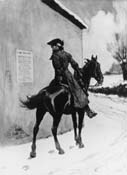

Just outside Haverhill, on the back road into Saffron
Walden, lies the small village of Hempstead. You might well drive through
it without a moment’s thought but if you new it was the birthplace
of the infamous Highway man Dick Turpin you might well give it another
look. Turpin was the most notorious Highwayman of his day and his exploits
have become the stuff of legend. Even his horse Black Bess has achieved
an almost cult status. But what of the real Dick Turpin? Was he hero or
villain?
Haverhill Life investigates the true story of his life.
A Life Feature on Dick Turpin: Highwayman
From about 1730 they lived at Buckhurst Hill, Essex, but Turpin soon became
involved with the Gregory gang of deer-stealers in the royal forest of
Epping, acting as their fence. When some of the gang were taken in February
1735, the youngest member turned evidence, and descriptions and rewards
for the capture of the rest, including Turpin, "a fresh coloured
man, very much marked with the small pox", were posted. By December
only Turpin and one other member, Thomas Rowden, remained at large.
They now took to highway robbery south of the Thames, but
by May 1736 had separated when Rowden fled to Gloucester, where he was
later captured and convicted of counterfeiting. Turpin, however, disappeared
completely, although there were suggestions that he had gone to the Netherlands.
In February 1737, ostensibly upon the authorities learning of Turpin's
intention to return home and rendezvous with friends, an ambush was laid
at Puckeridge, Hertfordshire, and although Turpin eluded capture his wife
and her companions were committed to Hertford gaol on suspicion of highway
robbery, but afterwards released.
Turpin then took up with Matthew King, whom he may have known already,
and stole a racehorse called Whitestockings, which was soon traced to
a stable in Whitechapel.
On 5 May a desperate Turpin, having shot and killed a man who attempted to capture him, anticipated the posting of a £200 reward by fleeing to Yorkshire, a prudent course, as his description had been enhanced, "of a brown complexion - his cheek bones broad, his face thinner towards the bottom, his visage short, pretty upright, and broad about the shoulders".
By early 1738 Turpin was the last member of the original Gregory gang to remain free. During the summer he stole horses in Lincolnshire and returned with them to Brough to sell in Yorkshire. On 16 August Richard stole three more horses, the identification of two of which was to prove instrumental in his downfall.

In October 1738 Turpin was arrested (in the name of John
Palmer) for disturbing the peace and committed to the house of correction
at Beverley. However, when it emerged that he might be implicated in horse-stealing,
he was removed to York Castle where he was charged.
In February 1739 Turpin sent a letter to his family asking for help but
his brother refused to pay the postage. In the argument that followed
Turpin’s true identity was revealed. At the end of March Richard
was tried and convicted, and executed at York on 7 April 1739, he was
34 years old.
After Turpin’s death there was little promotion of
his exploits until they began to appear in popular magazines around 1800,
and it was at this point that the famous ride from London to York to establish
an alibi, became a feature of the Turpin literature.
This feat of equestrian endurance (previously attributed to the highwayman
William Nevison) was then put to good use by Harrison Ainsworth, who not
only included Turpin in his 1834 novel Rookwood but, at the end of an
enthralling ride, had Black Bess, Turpin’s Horse, expire at York.
The publication in 1836 of six prints of dramatic incidents in Turpin's
career secured him a place in juvenile drama, the publishers of which
plagiarised the prints and, by increment, ensured his lasting fame in
pottery, circus, theatre, comics, cinema, TV, and advertising.
Turpin, therefore, is the classic example of a criminal who changes from
villain into mythical hero, and in so doing achieves immortality. This
status notwithstanding, his body is reputed to be buried in St George's
churchyard, York.
• Extracted from the Oxford Dictionary of National Biography
by Derek Barkw.
Copyright © Oxford University Press.
The Bluebell Inn, Hempsted
Stand and Deliver!!
DICK TURPIN (1705-1739), HIGHWAYMAN, was
baptised on 21 September 1705 at Hempstead, Essex, the fifth child of
John Turpin and Mary Parmenter.
He was born at the Blue Bell Inn (later the Rose and Crown), Hempstead,
where his father, formerly a butcher, was publican. Testimony given at
his trial in 1739 stated that Richard, otherwise known as Dick Turpin,
had a rudimentary education before he became a butcher and married Betty
Millington, a maid-servant.